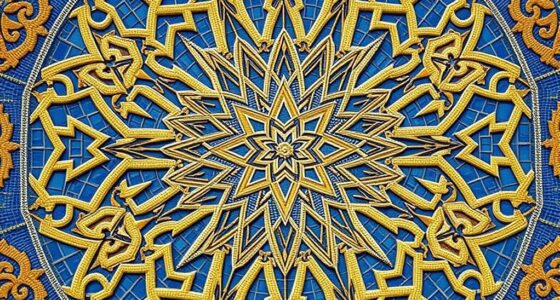Understanding the difference between a labyrinth and a maze helps you see their spiritual roles clearly. A labyrinth offers a single, winding path that guides you inward, encouraging reflection and calmness as a meditative journey. A maze, with its complex branches and dead ends, challenges your problem-solving skills and creates excitement or frustration. If you explore further, you’ll discover how each structure uniquely symbolizes life’s spiritual and emotional journeys.
Key Takeaways
- A labyrinth features a single, unambiguous path symbolizing spiritual journeys, while a maze has multiple routes and dead ends representing life’s challenges.
- Walking a labyrinth promotes meditation and inward reflection, whereas navigating a maze emphasizes problem-solving and mental agility.
- Labyrinths are traditionally used for spiritual growth, mindfulness, and inner peace; mazes often symbolize life’s uncertainties and external obstacles.
- The design of labyrinths reflects harmony and spiritual symbolism, contrasting with maze structures designed for complexity and navigation challenges.
- Both serve as metaphorical tools: labyrinths for inward exploration and enlightenment, mazes for outward challenge and discovery.

Have you ever wondered what distinguishes a labyrinth from a maze? While they might look similar at first glance, their purposes and designs are quite different. A labyrinth is typically a single, winding pathway that leads to a central point and back out again. It’s often used as a tool for meditative walking, where the focus is on the journey inward rather than on finding a way out. When you walk a labyrinth, you follow a continuous path that encourages reflection, mindfulness, and a deeper connection to your inner self. This deliberate, unambiguous route holds strong symbolic meanings—representing life’s spiritual journey, personal growth, or the search for enlightenment. The act of walking it slowly and intentionally can help clear your mind and foster a sense of peace, making it more than just a physical exercise; it becomes a meaningful ritual. Additionally, the design of a labyrinth often reflects traditional home architecture principles, emphasizing harmony and spiritual symbolism.
In contrast, a maze is designed to challenge your problem-solving skills. Its complex, branching pathways often have dead ends and multiple routes, all meant to confuse or test your navigation abilities. Unlike the straightforward design of a labyrinth, a maze can evoke feelings of frustration or excitement as you try to find the correct path. There’s less emphasis on inward reflection and more on mental engagement. When you encounter a maze, your focus tends to shift from mindfulness to strategy, trying different routes until you reach the goal or give up. The symbolic meanings of mazes can vary—from representing life’s uncertainties and challenges to serving as a metaphor for spiritual tests or rites of passage. They can also symbolize a quest for knowledge or self-discovery, but the process is often more about overcoming obstacles than meditative contemplation.
Understanding these differences helps you appreciate their significance beyond mere entertainment. A labyrinth invites you into a tranquil experience, where walking becomes a form of prayer or meditation. Its design encourages you to slow down, breathe, and reflect on your personal journey. Meanwhile, a maze challenges your intellect and perseverance, pushing you to think creatively and stay focused amid confusion. Both serve as powerful symbols—one for inward spiritual exploration, the other for outward challenge and discovery. Recognizing these distinctions allows you to choose the right pathway for your intentions, whether you seek solace and insight or adventure and problem-solving. Ultimately, both labyrinths and mazes can enrich your understanding of life’s complexities and your own inner landscape.
Frequently Asked Questions
How Do Labyrinths Influence Meditation Practices?
Labyrinths influence your meditation practices by guiding meditative focus and encouraging spiritual journeying. As you walk their winding paths, you can clear your mind and deepen your connection to inner thoughts. The deliberate, contemplative movement helps you stay present, fostering mindfulness and clarity. This process supports your spiritual journeying, allowing you to explore your inner self with intention and calm, making labyrinths powerful tools for enhancing meditation.
What Cultures Historically Used Labyrinths and Mazes Spiritually?
Imagine a world where labyrinths and mazes shape your spiritual journey—ancient cultures knew this power well. You’ll find meditative symbolism and deep cultural significance in Greek labyrinths at Knossos, while Native American tribes used intricate mazes for spiritual rites. In medieval Europe, labyrinths symbolized divine paths, guiding souls toward enlightenment. Each culture embraced these structures to connect with higher domains, making them timeless tools of spiritual exploration.
Can Labyrinths Aid in Mental Health and Healing?
You may find that walking a labyrinth can support mental health and healing by encouraging mindfulness techniques. As you navigate its path, you focus on each step, calming your mind and reducing stress. This mindful practice fosters emotional healing by helping you process feelings and gain clarity. Unlike mazes, labyrinths offer a purposeful, meditative journey that promotes relaxation, self-awareness, and emotional resilience, making them valuable tools for mental wellness.
Are There Specific Rituals Associated With Labyrinth Walking?
You might wonder if specific rituals accompany labyrinth walking. Many believe meditative walking through a labyrinth embodies ritual symbolism, enhancing spiritual connection. While formal rituals vary, common practices include setting intentions before walking, pausing at the center for reflection, and expressing gratitude upon exit. These rituals deepen your experience, transforming labyrinth walking into a meaningful spiritual practice that fosters mindfulness, healing, and personal insight.
How Do Maze Designs Reflect Spiritual Symbols?
You see that maze designs often reflect spiritual symbols through symbolic geometries and mythological motifs. These intricate patterns embody deeper meanings, guiding you through spiritual journeys or representing life’s complexities. By traversing these structures, you connect with universal symbols that evoke inner reflection and growth. The symbols serve as visual metaphors, helping you explore spiritual ideas while engaging with the creative artistry embedded in maze layouts.
Conclusion
Whether you walk a labyrinth or navigate a maze, both paths reveal inner truths. A labyrinth offers quiet reflection, guiding you inward, while a maze challenges your wit, pushing you outward. One invites serenity; the other sparks adventure. As you choose your spiritual journey, remember: one’s a gentle stream, the other a roaring river. Embrace each as a reflection of your inner quest—both paths, distinct yet united, lead to self-discovery.











